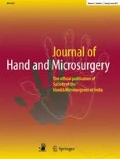Abstract
The elbow, forearm and wrist act as a unified structure to provide a stable, strong and highly mobile strut for positioning the hand in space and for conducting load-bearing tasks. An understanding of the relevant anatomy and biomechanics is important for the surgeon assessing and treating disorders of forearm function. This paper is concerned with illuminating the principles and concepts governing forearm rotation and load-bearing functions.
Similar content being viewed by others
References
Weiss APC, Hastings H (1992) The anatomy of the proximal radioulnar joint. J Shoulder Elbow Surg 1: 193–199
Grey’s Anatomy. (2005) 39th ed. Elsevier, Churchill Livingstone. Edinburgh. Section 5. Chapter 53. pp 901–909
af Ekenstam F, Hagert CG (1985) Anatomical studies on the geometry and stability of the distal radio ulnar joint. Scand J Plast Reconstr Surg 19:17–25
Tolat AR, Stanley JK, Trail IA (1996) Cadaveric study of the anatomy and stability of the distal radioulnar joint in the coronal and transverse planes. J Hand Surg 21B:587–594
Palmer AK, Werner FW (1981) The triangular fibrocartilage complex of the wrist — anatomy and function. J Hand Surg; 6A:153–162
Nakamura T, Yabe Y Horiuchi Y (1996) Functional anatomy of the triangular fibrocartilage complex. J Hand Surg 21B:581–586
Acosta R, Hnat W, Scheker LR (1993) Distal radioulnar ligament motion during supination and pronation. J Hand Surg 18B:502–505
Ishii S, Palmer AK, Werner FW et al. (1998) An anatomic study of the ligamentous structure of the triangular fibrocartilage complex. J Hand Surg 23A:977–985
Kleinman. WB (2007) Stability of the distal radioulnar joint: biomechanics, pathophysiology. Physical diagnosis, and restoration of function what we have learned in 25 years. J Hand Surg 32A:1086–1106
Xu J, Tang JB (2009) In vivo changes in lengths of the ligaments stabilizing the distal radioulnar joint. J Hand Surg 34A:40–45
Noda K, Goro A, Murase T et al. (2009) Interosseous membrane of the forearm: An anatomical study of ligament attachment locations. J Hand Surg 34A:415–422
Palmer AK, Werner FW (1984) Biomechanics of the distal radioulnar joint. Clin Orthop 187:26–35
Linscheid RL (1992) Biomechanics of the distal radioulnar joint. Clin Orthop Rel Res 275:46–55
Kihara H, Short WH, Werner FW et al. (1995) The stabilizing mechanism of the distal radioulnar joint during pronation and supination. J Hand Surg 20A:930–936
Shaaban H, Pereira C, Williams R et al. (2008) The effect of elbow position on the range of supination and pronation of the forearm. J Hand Surg; 33E:1:3–8
Russell CJH, Bush JA, Russell GWP et al. (2009) Dynamic skin tension in the forearm: Effects of pronation and supination. J Hand Surg 34A:423–431
Kalson N, Malone P, Redvers-Chubb K et al. (2009) Incidence of ulnar neuropathy in patients with distal radioulnar joint dysfunction. Poster. Combined meeting BSSH/ASSH, London
Hagert E, Garcia-Elias M, Forsgren S et al. (2007) Immunohisotchemical analysis of wrist ligament innervation in relation to their structural composition. J Hand Surg; 32A:30–36
af Ekenstam FW, Palmer AK, Glisson RR (1984) The load on the radius and ulna in different positions of the wrist and forearm. A cadaver study. Acta Orthop Scand 55:363–365
Birkbeck DP, Failla JM, Hoshaw SJ et al. (1997) The interosseous membrane affects load distribution in the forearm. J Hand Surg; 22A:975–980
Werner FW, Glisson RR, Murphy DJ et al. (1986) Force transmission through the distal radioulnar carpal joint: Effect of ulnar lengthening and shortening. Handchir Mikrochir Plast Chirug 18:304–308
Lees VC, Scheker LR (1997) The radiological demonstration of dynamic ulnar impingement. J Hand Surg 22B:448–450
Shaaban H, Giakis G, Bolton M et al. (2004) The distal radioulnar joint as a load-bearing mechanism — a biomechanical study. J Hand Surg 29A:1:85–90
Shaaban H, Giakis G, Bolton M et al. (2006) The loadbearing characteristics of the forearm: Pattern of axial and bending force transmitted through ulna and radius. J Hand Surg 31B:274–279
Shaaban H, Giakis G, Bolton M et al. (2007) Pattern of contact area inside the DRUJ and the effect of injury of the distal radioulnar ligaments. Clin Biomechanics 22:313–318
Chandler JW, Stabile KJ, Pfaeffle HJ et al. (2003) Anatomic parameters for planning of interosseous ligament reconstruction using computer-assisted techniques. J Hand Surg 28A:111–116
Pfaeffle HJ, Stabile KJ, Li ZM et al. (2005) Reconstruction of the interosseous ligament restores normal forearm compressive load transfer in cadavers. J Hand Surg; 30A:319–325
Bowers WH (1998) The distal radioulnar joint. in Green’s Operative Hand Surgery, Churchill Livingstone, New York, 4th edn, pp 1011–1015
Scheker LR, Belliappa PP, Acosta R et al. (1994) Reconstruction of the dorsal ligament of the triangular fibrocartilage complex. J Hand Surg 19B:310–318
Adams BD, Berger RA (2002) An anatomic reconstruction of the distal radioulnar ligaments for posttraumatic distal radioulnar joint instability. J Hand Surg 27A:243–251
Hagert CG. (1994) Distal radius fracture and the distal radioulnar joint-Anatomical considerations. Hand Chir. Mikrochir. Plast. Chir. 22–26
Lees VC, Scheker LR (2007) Load distributing function of the distal radioulnar joint — biomechanics and total replacement arthroplasty. Proceedings 10th IFSSH Congress, Sydney, Medimond, Bologna, Italy
Scheker LR, Severo A (2001) Ulnar shortening for the treatment of early post-traumatic osteoarthritis at the distal radioulnar joint. J Hand Surg 26B:41–44
Laurentin-Perez LA, Goodwin AN, Babb BA et al. (2008) A study of functional outcome following implantation of a total distal radioulnar joint prosthesis. J Hand Surg 33E:18–28
Garcia-Elias M (2007) Eclypse: partial ulnar head replacement for the isolated distal radio-ulnar joint arthrosis. Techniques Hand Upper Extrem Surg 11:121–128
Herbert TJ, van Schoonhoven J (2007) Ulnar head replacement. Tech Hand Upper Extrem Surg 11:98–108
Author information
Authors and Affiliations
Corresponding author
Rights and permissions
About this article
Cite this article
Lees, V.C. The functional anatomy of forearm rotation. J Hand Microsurg 1, 92–99 (2009). https://doi.org/10.1007/s12593-009-0022-7
Received:
Accepted:
Published:
Issue Date:
DOI: https://doi.org/10.1007/s12593-009-0022-7




